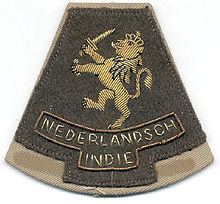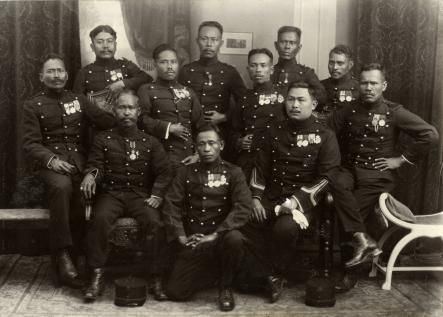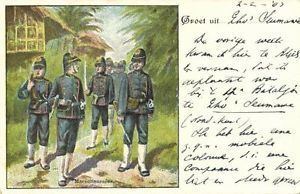Date founded 1819 | Founder Netherlands | |
 | ||
Disbanded 1950 (1951 Colonial Reserve disbanded) Similar Royal Netherlands Army, Armed forces of the Nethe, Royal Netherlands Navy, Netherlands Naval Aviation, Royal Netherlands Air Force | ||
Royal netherlands east indies army knil 1819 1950
The Royal Netherlands East Indies Army (Koninklijk Nederlands Indisch Leger; KNIL) was the military force maintained by the Netherlands in its colony of the Netherlands East Indies (also known as the Dutch East Indies), in areas that are now part of Indonesia. The KNIL's air arm was the Royal Netherlands East Indies Army Air Force. Elements of the Royal Netherlands Navy were also stationed in the Netherlands East Indies.
Contents
- Royal netherlands east indies army knil 1819 1950
- Military aviation of the royal netherlands east indies army ml knil 1915 1950
- History 18301942
- World War II
- Order of battle 12 December 1941
- 19451950
- Recruiting
- References

Military aviation of the royal netherlands east indies army ml knil 1915 1950
History 1830–1942

The KNIL was formed by royal decree on 10 March 1830. It was not part of the Royal Netherlands Army, but a separate military arm specifically formed for service in the Netherlands East Indies. Its establishment coincided with the Dutch drive to expand colonial rule from the 17th century area of control to the far larger territories comprising the Dutch East Indies seventy years later.

The KNIL was involved in many campaigns against indigenous groups in the area including the Padri War (1821–1845), the Java War (1825–1830), crushing the final resistance of Bali inhabitants to colonial rule in 1849, and the prolonged Aceh War (1873–1904). In 1894, Lombok and Karangasem were annexed in response to reports of the local Balinese aristocracy oppressing the native Sasak people. Bali was finally taken under full control with the Dutch intervention in Bali (1906) and the final Dutch intervention in Bali (1908).

In the nineteenth and early twentieth centuries, the KNIL prosecuted the conquest of the Indonesian archipelago. After 1904 the Netherlands East Indies were considered pacified, with no large-scale armed opposition to Dutch rule until World War II, and the KNIL served a mainly defensive role protecting the Dutch East Indies from the possibility of foreign invasion.
Once the archipelago was considered pacified the KNIL was mainly involved with military policing tasks. To ensure a sizeable European military segment in the KNIL and reduce costly recruitment in Europe, the colonial government introduced obligatory military service for all resident male conscripts in the European legal class in 1917. In 1922 a supplemental legal enactment introduced the creation of Home Guard (Dutch: Landstorm) for European conscripts older than 32.
No large-scale armed threat to Dutch rule existed until World War II.
World War II
Dutch forces in the Netherlands East Indies were severely weakened by the defeat and occupation of the Netherlands itself, by Nazi Germany, in 1940. The KNIL was cut off from external Dutch assistance, except by Royal Netherlands Navy units. The KNIL, hastily and inadequately, attempted to transform into a modern military force able to protect the Dutch East Indies from foreign invasion. By December 1941, Dutch forces in Indonesia numbered around 85,000 personnel: regular troops comprised about 1,000 officers and 34,000 enlisted soldiers, of whom 28,000 were indigenous. The remainder were made up of locally organised militia, territorial guard units and civilian auxiliaries. The KNIL air force, Militaire Luchtvaart KNIL (Royal Netherlands East Indies Air Force (ML-KNIL)) numbered 389 planes of all types, but was largely outclassed by superior Japanese planes. The Royal Netherlands Navy Air Service, or MLD, also had significant forces in the NEI.
During the Dutch East Indies campaign of 1941–42, most of the KNIL and other Allied forces were quickly defeated. Most European soldiers, which in practice included all able bodied Indo-European males, were interned by the Japanese as POWs. 25% of the POWs did not survive their internment.
A handful of soldiers, mostly indigenous personnel, mounted guerilla campaigns against the Japanese. These were usually unknown to, and unassisted by, the Allies until the end of the war.
During early 1942, some KNIL personnel escaped to Australia. Some indigenous personnel were interned in Australia under suspicion of sympathies with the Japanese. The remainder began a long process of re-grouping. In late 1942, a failed attempt to land in East Timor, to reinforce Australian commandos waging a guerrilla campaign ended with the loss of 60 Dutch personnel.
Four “Netherlands East Indies” squadrons (the RAAF-NEI squadrons) were formed from ML-KNIL personnel, under the auspices of the Royal Australian Air Force, with Australian ground staff.
KNIL infantry forces (much like their counterparts in the UK), were augmented by recruitment among Dutch expatriates around the world and by colonial troops from as far away as the Dutch West Indies. During 1944–45, some small units saw action in the New Guinea campaign and Borneo campaign.
Order of battle, 12 December 1941
Koninklijk Nederlands Indisch Leger or KNIL (Army status), commanded by Lt. Gen. Hein Ter Poorten.
1st Military Area (Division status), overseeing western part of Java, coterminous with 1st Infantry division, commanded by Maj. Gen. W. Schilling. Combat units:
Maneuver units:
Detached units:
Fire Support units:
Other Support units:
Army Aviation units:
2nd Military Area (Division status), overseeing central part of Java, coterminous with 2nd Infantry division, commanded by Maj. Gen. P.A. Cox. Combat units:
Detached units:
Fire Support unit:
Other Support units:
Army Aviation units:
3rd Military Area (Division status), overseeing eastern part of Java, manned by 3rd Infantry division, commanded by Maj. Gen. G.A. Ilgen. Combat units:
Maneuver units:
Detached units:
Fire Support units:
Other Support units:
Army Aviation unit:
Sumatra High Command (Division status), overseeing the island of Sumatra, commanded by Maj. Gen. R.T. Overakker. The Sumatra High Command divided into four territorial commands, i.e. North Sumatra, West Sumatra, Riouw and South Sumatra.
North Sumatra Territorial Command (Regiment status), overseeing northern part of Sumatra, commanded by Col. G.F.V. Gosenson. Combat units in Koetaradja:
Combat units in Medan:
Detached units:
Fire Support units:
Other Support unit:
West Sumatra & Tapanoeli Territorial Command (Regiment status), overseeing western part of Sumatra, commanded by Lt. Col. J.H.M. Blogg. Combat units:
Detached units:
Fire Support units:
Other Support unit:
Riouw Territorial Command (Regiment status), overseeing eastern part of Sumatra, commanded by Maj. J.H. de Vries. Combat units:
Support unit:
South Sumatra Territorial Command (Regiment status), overseeing southern part of Sumatra, commanded by Lt. Col. L.W.N. Vogelsang. Combat units in Palembang:
Combat units in Djambi:
Fire Support units:
Other Support unit:
West Borneo Territorial Command (Regiment status), overseeing western part of Borneo, commanded by Lt. Col. D.P.F. Mars. Combat units:
Detached units:
Other Support unit:
South and East Borneo Territorial Command (Regiment status), overseeing southern and eastern part of Borneo, commanded by Lt. Col. H.T. Halkema. Combat units:
Detached units:
Fire Support unit:
Other Support unit:
Balikpapan Local Command (Regiment status), overseeing the city of Balikpapan, commanded by Lt. Col. C. van den Hoogenband. Combat unit:
Fire Support unit:
Detached unit:
Other Support unit:
Tarakan Local Command (Regiment status), overseeing the city of Tarakan, commanded by Lt. Col. S. de Waal. Combat unit:
Fire Support unit:
Other Support units:
Samarinda Local Command (Battalion status), overseeing the city of Samarinda, commanded by Capt. G.A.C. Monteiro. Combat units:
Fire Support unit:
Other Support unit:
Samarinda II Air Base Local Command (Battalion status), overseeing Samarinda II Air Base, commanded by Maj. G. du Rij van Beest Holle. Combat unit:
Fire Support unit:
Other Support unit:
Celebes Territorial Command (Brigade status), overseeing the island of Celebes, commanded by Col. M. Vooren. The Celebes Territorial Command divided into three local commands, i.e. Manado, Kendari and Makassar.
Manado Local Command (Regiment status), overseeing the northern part of Celebes, commanded by Maj. B.F.A. Schilmöller. Combat units:
Fire Support unit:
Other Support unit:
Kendari II Airbase Garrison (Battalion status), overseeing Kendari II Airbase, commanded by Capt. F.B. van Straalen. Combat units:
Fire Support units:
Makassar Local Command (Battalion status), overseeing the southern part of Celebes Combat units:
Fire Support unit:
Other Support units:
Timor Territorial Command (Regiment status), overseeing Lesser Sunda Islands, commanded by Lt. Col. W.E.C. Detiger. Combat units:
Detached unit:
Other Support unit:
Moluccas Territorial Command (Regiment status), overseeing Moluccas Islands, commanded by Lt. Col. J.L.R. Kapitz. Combat units:
Detached units:
Fire Support unit:
Other Support units:
Military Aviation of the Royal Netherlands East Indies Army (Brigade status), based in Soerabaja, commanded by Lt. Gen. L.H. van Oyen, acting commander Col. E.T. Kengen.
1945–1950
Following World War II, the KNIL was used in two large military campaigns in 1947 and 1948 to re-establish Dutch control of Indonesia. The KNIL and its Ambonese auxiliaries have been accused of committing war crimes during this "police action". Dutch efforts to re-establish their colony failed and Netherlands recognition of Indonesian sovereignty came on 27 December 1949. On 26 January 1950, elements of the KNIL were involved in an abortive coup in Bandung planned by Raymond Westerling and Sultan Hamid II. The coup failed and only accelerated the dissolution of the federal Republic of the United States of Indonesia.
The KNIL was disbanded by 26 July 1950 with its indigenous personnel being given the option of demobilising or joining the Indonesian military. However, efforts to integrate former KNIL units were impeded by mutual distrust between the predominantly Ambonese KNIL troops and the Javanese-dominated Republican military; leading to clashes at Makassar in April and the attempted secession of an independent Republic of South Maluku (RMS) in July. These revolts were suppressed by November 1950 and approximately 12,500 Ambonese KNIL personnel and their families opted for temporary resettlement in the Netherlands. Following this, the KNIL ceased to exist but its traditions are maintained by the Regiment Van Heutsz of the modern Royal Netherlands Army. At the time of disbandment the KNIL numbered 65,000, of whom 26,000 were incorporated into the new Indonesian Army. The remainder were either demobilised or transferred to the Netherlands Army.
Recruiting
During the 19th century the KNIL recruited Dutch volunteers and foreign mercenaries of several nationalities. During the protracted Aceh War the numbers of European troops were kept to 12,000 but continued Achenese resistance necessitated the deployment of up to 23,000 indigenous soldiers (mainly from Java, Ambon, and Manado). Even slaves of the Ashanti (Ivory Coast and Ghana) were recruited in limited numbers for service in the East Indies (see Belanda Hitam). The ratio of foreign and indigenous troops to those of Dutch origin was reported to be 60% to 40%. After the Aceh War, the enlistment of non-Dutch European troops ceased and the KNIL came to consist of Dutch regulars recruited in the Netherlands itself, Indonesians, Indos (Eurasians), and Dutch colonists living in the East Indies and undertaking their military service.
In 1884 personnel strength was numbered at 13,492 European, 14,982 Indonesian, 96 African, and at least 1,666 Eurasian recruits. The officer corps was wholly European and was probably close to 1,300. There were also about 1,300 horses. Recruitment was carried out in Holland and India, with over 1,000 Dutch subjects and 500 other nationalities enlisting annually. The foreign troops consisted of Flemish, German, Swiss, and French volunteers. Walloons, Arabs, and nationals of both the United Kingdom and United States were forbidden from serving. Other foreigners who could not prove fluency in either Dutch or German were also not accepted for service.
It was against the law to send Dutch conscripts from the Netherlands to the East Indies but Dutch volunteers continued to enlist for colonial service in the KNIL. In 1890 a Colonial Reserve (Koloniale Reserve) was established in the Netherlands itself to recruit and train these volunteers and to re-integrate them into Dutch society upon the conclusion of their overseas service. On the eve of the Japanese invasion in December 1941, Dutch regular troops in the East Indies comprised about 1,000 officers and 34,000 men, of whom 28,000 were indigenous. The largest proportion of these "native troops" had always consisted of Javanese and Sundanese soldiers. During the Japanese occupation, most of the Dutch and Ambonese personnel were interned in POW camps.
During the Indonesian National Revolution, the KNIL's officers were still largely Dutch and Eurasians although most of its troops were recruited from predominantly Christian eastern Indonesia, particularly the South Moluccas, Timor and Manado. Although there were smaller numbers of Javanese, Sundanese, Sumatran and other Muslim troops in Dutch service, these received comparatively lower rates of pay than their Christian counterparts, leading to resentment and distrust. The Dutch sought to take advantage of these ethnic tensions by claiming that the Ambonese would lose their special privileges and pensions under a Javanese-dominated government. As noted above, these factors contributed to clashes between demobilised KNIL units and the Republic of Indonesia's military throughout 1950.
